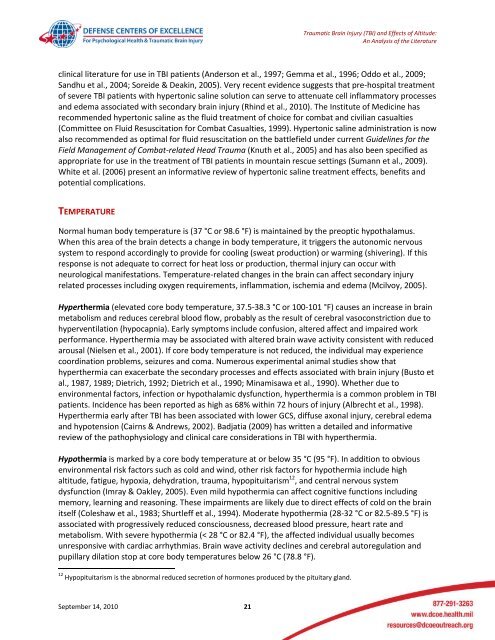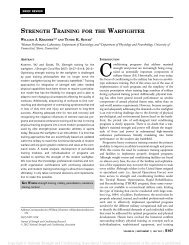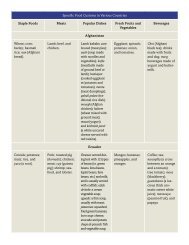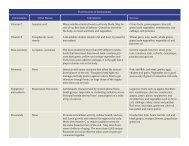Traumatic Brain Injury and Effects of Altitude - Human Performance ...
Traumatic Brain Injury and Effects of Altitude - Human Performance ...
Traumatic Brain Injury and Effects of Altitude - Human Performance ...
You also want an ePaper? Increase the reach of your titles
YUMPU automatically turns print PDFs into web optimized ePapers that Google loves.
<strong>Traumatic</strong> <strong>Brain</strong> <strong>Injury</strong> (TBI) <strong>and</strong> <strong>Effects</strong> <strong>of</strong> <strong>Altitude</strong>:An Analysis <strong>of</strong> the Literatureclinical literature for use in TBI patients (Anderson et al., 1997; Gemma et al., 1996; Oddo et al., 2009;S<strong>and</strong>hu et al., 2004; Soreide & Deakin, 2005). Very recent evidence suggests that pre-hospital treatment<strong>of</strong> severe TBI patients with hypertonic saline solution can serve to attenuate cell inflammatory processes<strong>and</strong> edema associated with secondary brain injury (Rhind et al., 2010). The Institute <strong>of</strong> Medicine hasrecommended hypertonic saline as the fluid treatment <strong>of</strong> choice for combat <strong>and</strong> civilian casualties(Committee on Fluid Resuscitation for Combat Casualties, 1999). Hypertonic saline administration is nowalso recommended as optimal for fluid resuscitation on the battlefield under current Guidelines for theField Management <strong>of</strong> Combat-related Head Trauma (Knuth et al., 2005) <strong>and</strong> has also been specified asappropriate for use in the treatment <strong>of</strong> TBI patients in mountain rescue settings (Sumann et al., 2009).White et al. (2006) present an informative review <strong>of</strong> hypertonic saline treatment effects, benefits <strong>and</strong>potential complications.TEMPERATURENormal human body temperature is (37 °C or 98.6 °F) is maintained by the preoptic hypothalamus.When this area <strong>of</strong> the brain detects a change in body temperature, it triggers the autonomic nervoussystem to respond accordingly to provide for cooling (sweat production) or warming (shivering). If thisresponse is not adequate to correct for heat loss or production, thermal injury can occur withneurological manifestations. Temperature-related changes in the brain can affect secondary injuryrelated processes including oxygen requirements, inflammation, ischemia <strong>and</strong> edema (Mcilvoy, 2005).Hyperthermia (elevated core body temperature, 37.5-38.3 °C or 100-101 °F) causes an increase in brainmetabolism <strong>and</strong> reduces cerebral blood flow, probably as the result <strong>of</strong> cerebral vasoconstriction due tohyperventilation (hypocapnia). Early symptoms include confusion, altered affect <strong>and</strong> impaired workperformance. Hyperthermia may be associated with altered brain wave activity consistent with reducedarousal (Nielsen et al., 2001). If core body temperature is not reduced, the individual may experiencecoordination problems, seizures <strong>and</strong> coma. Numerous experimental animal studies show thathyperthermia can exacerbate the secondary processes <strong>and</strong> effects associated with brain injury (Busto etal., 1987, 1989; Dietrich, 1992; Dietrich et al., 1990; Minamisawa et al., 1990). Whether due toenvironmental factors, infection or hypothalamic dysfunction, hyperthermia is a common problem in TBIpatients. Incidence has been reported as high as 68% within 72 hours <strong>of</strong> injury (Albrecht et al., 1998).Hyperthermia early after TBI has been associated with lower GCS, diffuse axonal injury, cerebral edema<strong>and</strong> hypotension (Cairns & Andrews, 2002). Badjatia (2009) has written a detailed <strong>and</strong> informativereview <strong>of</strong> the pathophysiology <strong>and</strong> clinical care considerations in TBI with hyperthermia.Hypothermia is marked by a core body temperature at or below 35 °C (95 °F). In addition to obviousenvironmental risk factors such as cold <strong>and</strong> wind, other risk factors for hypothermia include highaltitude, fatigue, hypoxia, dehydration, trauma, hypopituitarism 12 , <strong>and</strong> central nervous systemdysfunction (Imray & Oakley, 2005). Even mild hypothermia can affect cognitive functions includingmemory, learning <strong>and</strong> reasoning. These impairments are likely due to direct effects <strong>of</strong> cold on the brainitself (Coleshaw et al., 1983; Shurtleff et al., 1994). Moderate hypothermia (28-32 °C or 82.5-89.5 °F) isassociated with progressively reduced consciousness, decreased blood pressure, heart rate <strong>and</strong>metabolism. With severe hypothermia (< 28 °C or 82.4 °F), the affected individual usually becomesunresponsive with cardiac arrhythmias. <strong>Brain</strong> wave activity declines <strong>and</strong> cerebral autoregulation <strong>and</strong>pupillary dilation stop at core body temperatures below 26 °C (78.8 °F).12 Hypopituitarism is the abnormal reduced secretion <strong>of</strong> hormones produced by the pituitary gl<strong>and</strong>.September 14, 2010 21





![Body Composition and Military [PDF] - Human Performance ...](https://img.yumpu.com/43269347/1/190x245/body-composition-and-military-pdf-human-performance-.jpg?quality=85)
![Tips for Grocery Shopping [PDF]](https://img.yumpu.com/37447379/1/190x245/tips-for-grocery-shopping-pdf.jpg?quality=85)



![Synthetic Drugs [PDF] - Human Performance Resource Center](https://img.yumpu.com/37447322/1/190x245/synthetic-drugs-pdf-human-performance-resource-center.jpg?quality=85)



